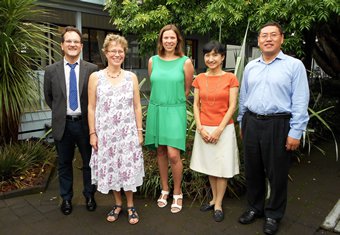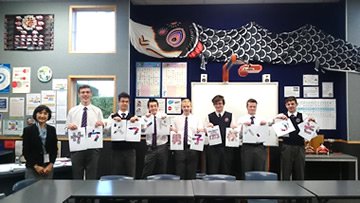New Zealand
New Zealand Ministry of Education
MIKAMI Kyoko
My Posting to New Zealand
New Zealand is an island nation divided into the North and South Islands situated on the opposite side of the equator from Japan. Accordingly, while the seasons are opposite those in Japan, there are also many geographical similarities, such as abundant nature, numerous volcanoes, and an area equaling nearly three quarters that of Japan.
However, one difference with Japan is the diverse languages and cultures found in New Zealand. While those of European descent represent the majority at roughly 74% of the total population of 4.6 million people, other major groups include the indigenous Maori at roughly 15% and Pasifika (people who are descendants of the Polynesian nations) at roughly 7%. There have also been numerous immigrants arriving in recent years from Asian countries such as China. English and Maori are the official languages, and both are represented in educational materials and signage at public facilities. The great respect for the Maori language and culture is also apparent from the presence of sacred Maori buildings on college campuses and the special rituals held when new members join the college staff.
The Work of Japanese-Language Specialists on Deployment
Since 2013, Japan Foundation Japanese-Language Specialists(hereinafter the “Specialists”) have been dispatch to Auckland, New Zealand’s largest city on the North Island, rather than the capital Wellington, the previous base of operations. The New Zealand Ministry of Education consigns programs for the promotion of foreign language learning to UniServices at the University of Auckland. Specialists serve as National Advisors assigned to a child organization to UniServices called International Languages Exchanges & Pathways (ILEP). In addition to the Japanese Advisors, there are also National Advisors for German, Spanish, French, and Chinese, each tasked with supporting teachers and spreading the learning of their respective languages. The other staff at ILEP include nearly 20 members who work together as a team, including advisors in charge of teacher training or promoting Asian language learning, managers in charge of running the overall program, and international exchange staff. Major conferences are held four times each year to bring the five National Advisors together with the rest of the staff. The photo below was taken at one of them.

Photo 1: The five National Advisors
Specialists are in charge of a variety of tasks, but the main focus is to visit schools where Japanese is taught. During these visits, the Specialists provide advice, introduce new teaching materials, and speak with school principals after observing the classes run by local teachers. The Specialists also give presentations using PowerPoint slides and video and host games to introduce Japanese language and culture. The National Advisors frequently visit rural areas because they must provide support to all schools throughout New Zealand.
In addition to school visits, other duties of the Specialists include regular meetings within the ILEP team and with managers, hosting workshops and meetings with teachers in each region, giving talks at language education seminars, participating in various activities, and liaison and collaboration with public relations and cultural centers at the embassy and consulates. Other important tasks for the Specialists include responding to phone calls and emails from teachers, consulting on teaching materials and Japanese-language teaching methods, class management, and applying to grant programs.
A Warm Welcome from Students During a School Visit
Photo 2 is from a visit in early May to a secondary school for boys in Invercargill, located at the south most tip of the South Island, where a Japanese teacher instructs children from grades 8 through 13 on the Japanese language. When I arrived at the school on the day of the visit, and entered the class, children from grade 11 (equivalent to the first year of high school in Japan) were making kinds of collages on the large cards. At first, I wondered what was going on, but it turned out that they were putting up letter cards to create a welcome message to me. Each child held their card and read the letter on it in turn, haltingly sounding out the words “Sa, U, Su, Ra, N, Do, Dan, Shi, Ko, Ko, Ni, Yo, Ko, So,” which I found quite moving.

Photo 2: Visiting a secondary school on the South Island
I spent the first part of that day observing the classes held by the teacher, and the second have giving a class on how to use chopsticks as an introduction to Japanese culture. After each child practiced holding the chopsticks on their own, I had them play a game where they had to pick up a small ball of chocolate and place it on the adjacent plate. I divided them into teams, and the students had a great deal of fun competing. It takes more than four hours to get from Auckland to Invercargill by air, involving a transfer mid-way, but I found many teachers in the city passionately teaching Japanese to their students, which I found very encouraging.
While I have only been here for four months, I intend to support Japanese-language classes as a National Advisor by visiting as many schools as possible and hosting workshops. I am also able to learn about the culture, lifestyles, and mindset of New Zealand through my interactions with the local teachers and students, which makes this a very rewarding job for me.
- What We Do Top
- Arts and Cultural Exchange [Culture]
- Japanese-Language Education Overseas [Language]
- Japanese-Language Education Overseas [Language] Top
- Learn Japanese-language
- Teach Japanese-language
- Take Japanese-Language Test
- Know about Japanese-language education abroad
- The Japanese-Language Institute, Urawa
- The Japanese-Language Institute, Kansai
- Japanese-Language Programs for Foreign Specified Skilled Worker Candidates
- Japanese Language Education for Japanese Children Resident Overseas and for the Descendants of Migrants
- Archives
- Japanese Studies and Global Partnerships [Dialogue]
- JF digital collection
- Other Programs / Programs to Commemorate Exchange Year
- Awards and Prizes
- Publications
